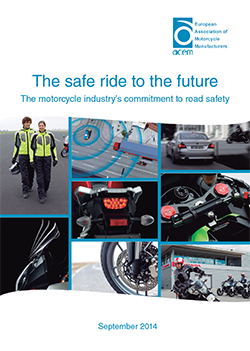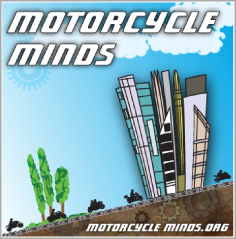 ACEM, the European Association of Motorcycle Manufacturers, has unveiled its new road safety strategy, the “Safe Ride to the Future” initiative to the world at the 10th International Motorcycle Conference (IfZ) in Cologne, Germany, which coincided with this year’s Intermot motorcycle show.
ACEM, the European Association of Motorcycle Manufacturers, has unveiled its new road safety strategy, the “Safe Ride to the Future” initiative to the world at the 10th International Motorcycle Conference (IfZ) in Cologne, Germany, which coincided with this year’s Intermot motorcycle show.
ACEM comments that the document sets out the European motorcycle industry’s commitment to road safety and proposes further improvements through an integrated approach covering vehicle technology, training and infrastructure safety.
Very fine words but what do they mean?
Having had a read through the document, our overall feeling is that it is a very good policy document for the industry in Europe to present to politicians and legislators, that motorcycling is making itself – technology safety robust – just like cars. It is a good document in that context.
The emphasis is on road safety, whether riders are conscious of this in their daily rides as individuals or whether rider organisations and industry trying to keep supporters, members and/or customers “safe” each with its own approach to the different issues mentioned in the document.
Issues such as technology, road infrastructure, integration into government transport policies and training are all relevant to motorcycling.
Of course the emphasis from ACEM’s perspective is to sell more motorcycles, thus the shift from advertising speed and thrills and power to “safety” technology is really a reflection of the dynamics within ACEM. For example, the President of ACEM Stephan Schaller, is also the President of BMW Motorrad.
The ACEM General Secretary is Antonio Perlot, aka “Diplomat extraordinaire” on the Brussels scene with an impressive network of politicians and civil servants with whom he can contact to promote the motorcycle industry. What better way to do this than by signing up to the European Union’s Road Safety agenda.
The ACEM document states, “The motorcycle industry believes that the number of fatalities amongst PTW users can and must be further reduced. For this reason, it is essential that all stakeholders (i.e. industry, and public authorities as well as users and non-governmental organisations) join forces to promote an integrated approach to road safety.”
Unveiling the master plan, the ACEM Secretary General Antonio Perlot said: “This strategy confirms ACEM members’ desire to be a leader in road safety. It highlights our ambition to have the best possible road safety outcomes for Europe.”
To that effect ACEM comments that they, “Will organise thematic workshops in close cooperation with industry national associations in order to gain a better understanding of what actions can be taken at local, regional and national level to improve safety for PTW riders. Moreover the motorcycle industry believes that all relevant stakeholders (e.g. users’ organisations, public authorities and non-governmental organisations) should take an active role and coordinate their efforts to further reduce PTW casualties.”
Western Outpost
From our small western outpost in the galaxy, we have a few comments to make with regards this impressive document. In the first instance and no disrespect intended, it seems that there was no consultation with other organisations such as FIM or FEMA and in that respect the document comes across as being somewhat condescending. For example, it would appear that ACEM is offering “out of the box” solutions which effectively may have the counter productive effect of stifling new training methods and innovation.
We just wonder whether any consideration was given to other training organisations apart from the one mentioned in the document (German Road Safety Council (DVR). Our experience in the United Kingdom is that inspite of various incentives to involve riders in post licence training, the uptake is really pitiful, so we are curious to understand how ACEM’s strategy would do any better.
From our own work with Road Traffic Collision Investigators, we know what the problems are and certainly the added technology such as ABS, electronic suspension systems and so forth will be very useful and important additions provided the cost does not outweigh the benefits. With regards the other issues such conspicuity i.e. lighting – we know that there is a major problem with other vehicle drivers and inattentional blindness.
We agree with ACEM that the focus needs to be on better training, but from our perspective, this training – i.e. collision avoidance and hazard awareness needs to be part of the Initial Rider Training, which was a FEMA project that ACEM was involved in. Governments have introduced the Third European Driving Licence Directive by varying degrees and as we (and a very small collective of know alls) are aware, ACEM was instrumental in getting this legislation through. At the time numerous riders’ organisations wanted the 3DLD to focus on training and assessments of riders’ abilities rather than testing.
For better or worse, we are where we are, but the way we see it, ACEM would do far more by aiming to convince EU member states to provide better initial rider training for all the reasons we mentioned above, rather than promoting “high quality” post license training scheme accreditation across the EU on their terms and what appears to be an effort to generate income.
Motorcycle Normal Vehicle
With regards eCall, this is a post crash system. This system has been discussed on previous occasions and it may make sense in sparsely populated countries like Finland etc. For those of us that live in densely populated countries – the passing motorist would be more likely to render aid than having to wait for an ambulance.
Our view is that with the proviso this system remains voluntary and an option to buy, it is what is appears to be, a device which in rare events may make a difference. As this is an after market system, it should be left to the after market industry to develop – because there are other alternatives from which riders can choose. Ultimately these are products on the open market and should remain as such.
The document lays out ACEM’s road safety policy which effectively explains how technology will be utilised to develop the motorcycle (the Powered Two Wheeler) to turn it into a “normal vehicle”, whatever that means.
What was interesting from our perspective, was that no where in that document did ACEM mention the Sea-change with regards advertising by manufacturers. For those of you who are not aware of this, in 2009 ACEM made a decision to stop promoting speed and thrills and advertising “ride like your hero” campaigns to hook young riders.
We recall how the policy makers from the European Commission were horrified with the publicity of one particular manufacturer promoting fast urban riding at an ACEM conference. How things change!
‘The safe ride to the future’ builds on previous safety initiatives such as ACEM members’ commitment to voluntarily fit all of their new vehicles with automatic headlamps on, the signing of the European Road Safety Charter and the decision to fit 75% of street motorcycle models with an advanced braking systems as an option or as standard fitting by 2015, in advance of respective regulatory requirements.
But as we know these voluntary commitments led to the eventual mandatory type approval legislation requiring these systems to be fitted. The paradox in this particular case was that at the time, the industry was against the mandatory fitting of ABS, but as explained to us by a representative of the Commission, a major reason for the proposal of mandatory ABS was because the industry was artificially hiking up the price of ABS systems!
“Information Overload”
While we are not averse to new technology, we do have concerns, especially with ITS (Intelligent Transport Systems). There is a major issue which is becoming apparent even amongst car manufacturers (e.g. Volvo) about problems of “Information overload” whereby the informed riders may have so much ITS “stuff” to deal with that this may well lead to distraction.
That is unless the legislators agree with the ACEM position that, “A mandatory approach, without distinguishing PTW categories, would be counterproductive.” and that, “…….it is equally critical that drivers and riders do not become over reliant on safety technologies for warnings of potential dangers.”
Furthermore, ACEM has made it clear that ITS that allows vehicles to interact with each other and with the surrounding infrastructure, “should under no circumstances negatively affect the riders’ control of the vehicle” and stresses “that not all ITS solutions may be suitable for all PTW categories.
Although ACEM’s members have signed a Memorandum of Understanding on ITS, committing themselves to installing safety-relevant co-operative ITS onto at least one of their PTW models by 2020.
There is recognition that, “the driving dynamics of powered-two and three-wheelers are much more complex than those of automobiles especially concerning – Advanced Driver Assistance Systems (ADAS), Adaptive Cruise Control (ACCA) or Autonomous Emergency Braking Systems (AEBS), which have been primarily engineered for use in cars, have the potential to be dangerous if applied to a PTW without the necessary adaptation to PTW dynamics. Powered-two and three-wheelers require a dedicated approach and specific engineering solutions to optimize the potential of ITS for road safety.”
Yesterday’s Rider
Although this would sit well with our own thoughts which is that a motorcycle is not a car, however legislators seem to like the idea that Powered Two Wheelers (PTWs) have experienced quite a significant change over the years, which makes the motorcycle (aka PTW) quite similar to a “normal vehicle” and perhaps in the rush to decrease motorcycle collisions and injuries, even faster that they are decreasing at the moment, the impetus to add all this technology, may effectively be turning our motorcycle into something else.
Would it mean that at some point in the not so distant future we will be fighting against a “third wheel”?
Consider that manufacturers are already unveiling their three wheeled concept vehicles and putting them on the market, similar in design to the already available Piaggio MP3.
In certain terms we think that this document will be difficult for present day riders to comprehend partly because of the reasons we have set out above.
In one respect, it is possibly something that younger riders and those who love gadgets might understand in their quest for new technology, in a world where products and advertising are more important than life style.
In other words will this leave present day motorcycle enthusiasts behind as “yesterday’s rider”?
On the one hand we should congratulate ACEM for publishing this document, because it allows observers such as ourselves the opportunity to have an insight into what ACEM’s position on motorcycling is and where it is heading.
On the other hand, this document raises serious questions about exactly where ACEM is heading.
From the perspective of an organisation that actively promotes motorcycles in their various forms and considers two wheeled transport to be the best means of travel, we find it difficult to understand why ACEM did not consult other rider organisations when putting together this document.
One thing is clear, all the technology and accredited training that this document proposes, will not be cheap.
Links & Information
Safe Ride to the Future – pdf – 2.88mb – Click Here
ACEM – www.acem.eu


Speak Your Mind